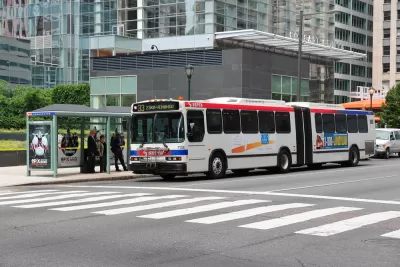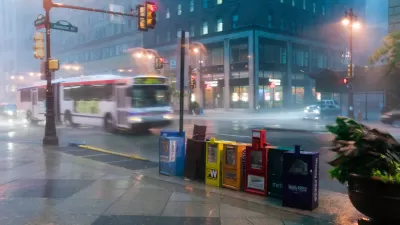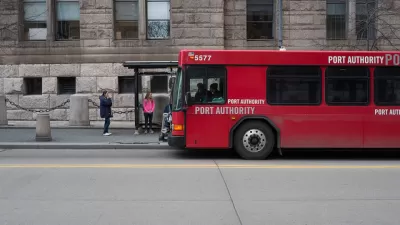New research documents the distance between bus stops in U.S. cities—a key question for service designers that determines a lot about the public transit user experience.

The journal Findings (née Transport Findings) this week published research by Ayush Pandey, Lewis Lehe, and Dana Monzer that quantifies bus stop spacing in U.S. cities.
The research, available online, features a database of bus stop spacings for 43 U.S. cities, weighting each spacing by the number of times a bus traverses the distance. Of the cities evaluated in the study, Las Vegas' Regional Transportation Commission (RTC) has the widest mean spacing (482 m) and Philadelphia's Southeastern Pennsylvania Transportation Authority (SEPTA) the narrowest (214 m).
According to the article's abstract, the research also compares spacings between the urban cores and more suburban locations within agencies' service areas.
FULL STORY: Distributions of Bus Stop Spacings in the United States

Alabama: Trump Terminates Settlements for Black Communities Harmed By Raw Sewage
Trump deemed the landmark civil rights agreement “illegal DEI and environmental justice policy.”

Study: Maui’s Plan to Convert Vacation Rentals to Long-Term Housing Could Cause Nearly $1 Billion Economic Loss
The plan would reduce visitor accommodation by 25% resulting in 1,900 jobs lost.

Why Should We Subsidize Public Transportation?
Many public transit agencies face financial stress due to rising costs, declining fare revenue, and declining subsidies. Transit advocates must provide a strong business case for increasing public transit funding.

Paris Bike Boom Leads to Steep Drop in Air Pollution
The French city’s air quality has improved dramatically in the past 20 years, coinciding with a growth in cycling.

Why Housing Costs More to Build in California Than in Texas
Hard costs like labor and materials combined with ‘soft’ costs such as permitting make building in the San Francisco Bay Area almost three times as costly as in Texas cities.

San Diego County Sees a Rise in Urban Coyotes
San Diego County experiences a rise in urban coyotes, as sightings become prevalent throughout its urban neighbourhoods and surrounding areas.
Urban Design for Planners 1: Software Tools
This six-course series explores essential urban design concepts using open source software and equips planners with the tools they need to participate fully in the urban design process.
Planning for Universal Design
Learn the tools for implementing Universal Design in planning regulations.
Smith Gee Studio
Alamo Area Metropolitan Planning Organization
City of Santa Clarita
Institute for Housing and Urban Development Studies (IHS)
City of Grandview
Harvard GSD Executive Education
Toledo-Lucas County Plan Commissions
Salt Lake City
NYU Wagner Graduate School of Public Service





























